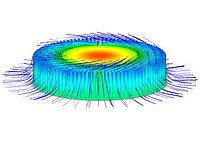
Photo from wikipedia
Statistical relations used for estimating the dissipation rate of turbulent kinetic energy (TKE) in isotropic turbulence from the inertial subrange of Lagrangian temporal and spatial structure functions are extended here… Click to show full abstract
Statistical relations used for estimating the dissipation rate of turbulent kinetic energy (TKE) in isotropic turbulence from the inertial subrange of Lagrangian temporal and spatial structure functions are extended here to the case of more realistic turbulence spectra that include low-frequency and low-wavenumber ranges. It is shown that using the traditional relations based only on the inertial subrange substantially underestimates the dissipation. The improved relations are better constrained by experimental data from which the dissipation is evaluated, enabling more accurate dissipation estimates. The concept is illustrated using laboratory data from water tank experiments of turbulence generated by an oscillating cylinder, where the dissipation is evaluated in three independent ways: from Lagrangian spectra and from Lagrangian temporal and spatial structure functions calculated from the motion of neutrally buoyant finite-sized particles. An additional correction to the relations for estimating the dissipation from the spatial structure functions is applied to take into account the filtering effect of the particles due to their finite size. It is found that, for these particular experiments, the TKE dissipation rate scales well with dimensionally consistent quantities built using the amplitude of the oscillation of the cylinder and the period of its motion, and the constant of proportionality in this scaling relation is determined using the method proposed here. Although the turbulence under consideration is quite anisotropic, the adopted theoretical framework, which assumes isotropic turbulence, seems to be applicable to the experimental data as long as the turbulence statistics are averaged over the three main flow directions.
Journal Title: Physics of Fluids
Year Published: 2023
Link to full text (if available)
Share on Social Media: Sign Up to like & get
recommendations!